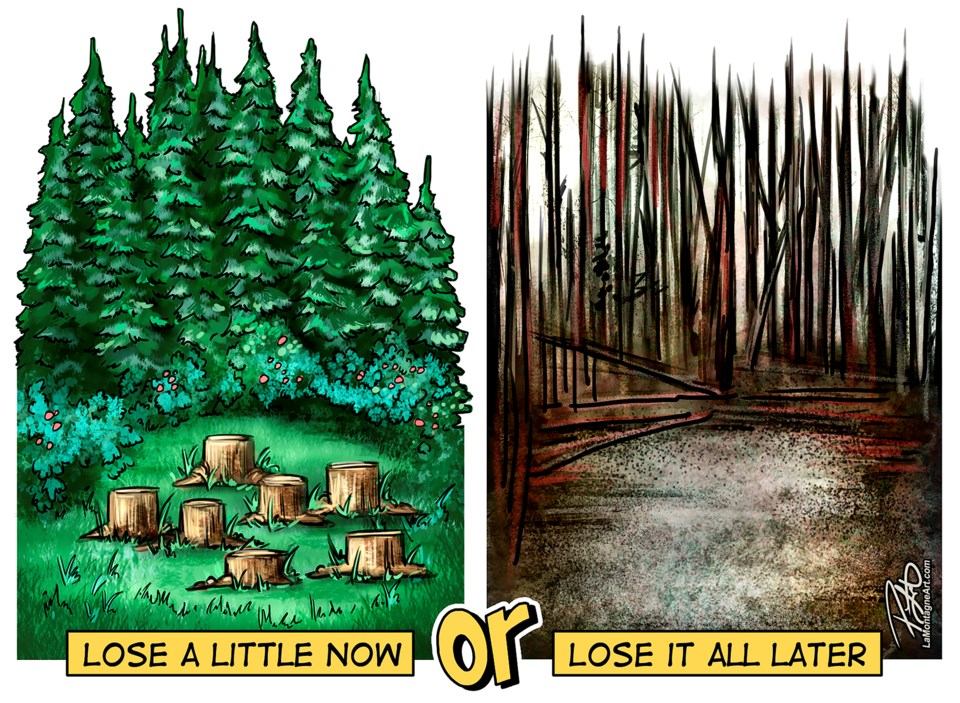The ongoing work to mitigate the fire risk in the Bow Valley will help residents and visitors for decades to come.
Previous mitigation work has been lengthy, with projects dating back several decades, but the most aggressive work done to protect the area has been done in the past year.
From Lake Louise, Banff and Canmore to the MD of Bighorn and Kananaskis Improvement District, extensive fireguards will be underway for years to come to enhance protection.
In Banff National Park, Lake Louise is working on a 165-hectare size fireguard and fire projects at Fairholme, Compound Meadows and Upper Red Deer Meadows are on the books. The Banff townsite has work taking place throughout the community and Parks Canada id logging a firebreak on Tunnel Mountain..
Around Canmore, Harvie Heights and Dead Man’s Flats, significant work is underway to both thin and harvest existing forests as well as planning future work.
In Kananaskis Country, a large fireguard in the area of Ribbon Creek near Kananaskis Village and around the Canmore Nordic Centre is taking place.
The region not only has a permanent population of about 30,000, but welcomes roughly 10 million visitors a year between the national parks and Kananaskis Country. It also serves as a vital economy corridor between Alberta and British Columbia.
The monumental undertaking is proof that when a specific task is identified, common goals established, and the safety of individuals and communities are at peril, multiple groups and organizations can come together to achieve important work.
Municipal, provincial and federal staff have also been doing non-stop rounds throughout the region updating the public about the ongoing work.
Residents and neighbourhoods have also come together. In Banff, areas such as Valleyview and Sulphur Court have been active, while Peaks of Grassi in Canmore is looking to be the mountain town’s first FireSmart recognized neighbourhood.
A key aspect of the work being done is that it is mitigation. It’s not entirely erasing the risk, which would be impossible, but advancing the existing level of protection.
Though it is unfortunate purse strings from higher levels of government came only after the Jasper wildfire devastated one of the premier tourist areas in Canada – which saw almost 33,000 hectares burned – the move to advance work to avoid a similar situation is not for nothing.
For many, there may be disappointment in losing parts of the ecosystem or the changing landscape.
Losing a swath of forest in certain areas of the Bow Valley is unfortunate, but so too would be the large devastation of the entire region to wildfire.
The short-term pain of not having access to small parts of the Legacy Trail between Banff and Canmore is worth the long-term gain of increased community protection.
The reality of climate change is the risk of wildfire throughout the country is only going to grow without addressing the root cause of the problem, which will take all levels of government across the world working to create solutions.
It takes not only levels of government working toward the goal, but also residents. In 2024, Alberta Wildfire responded to 1,210 wildfires that burned more than 705,000 hectares. Of those wildfires, the agency suspected 620 were human-caused.
As the wildfire season in Alberta now runs from March 1 to Oct. 31, with the winter weather leaving after a mild season and the dry weather of spring and summer inbound, the upcoming months have the potential to be worse than past years.
It takes everyone doing their part to ensure the protection of communities.




